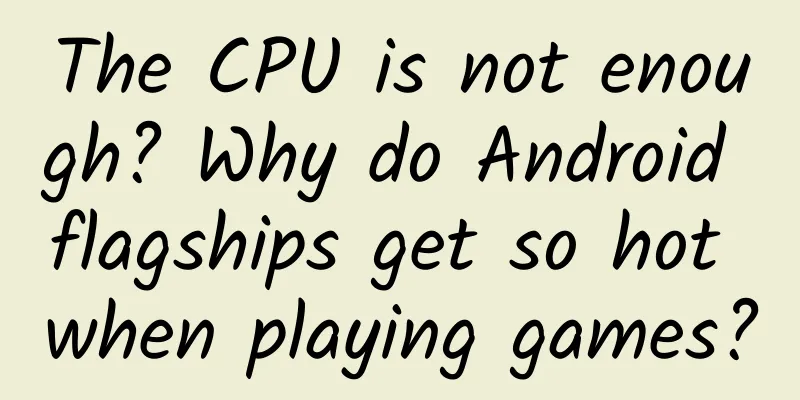The CPU is not enough? Why do Android flagships get so hot when playing games?

|
The heating of mobile phones is definitely a headache. Daily use and long talk time will cause the phone to heat up. What is even more annoying is that when playing large-scale mobile games, it is not the pleasure brought by the game that is frightening, but the hot temperature of the phone. With the increasing popularity of mobile phones, various mobile phone manufacturers have also made great efforts to reduce the problem of mobile phone heating. Manufacturers that focus on cost-effectiveness have put high-end components in low-end mobile phones. Better components mean lower power consumption. We can say goodbye to phenomena such as heating up after playing for a long time and fever after playing mobile games, which greatly improves the user experience of mobile phones. Why Android phones become hand warmers The main reasons for mobile phone heating are as follows. There are two aspects of heating when the mobile phone is talking: 1. The mobile phone consumes a lot of electricity when talking, and the discharge current of the battery is much larger than that when it is in standby mode, so the battery will generate a certain amount of heat; 2. The components that emit heat in the mobile phone chip: the power amplifier. The power amplifier chip responsible for receiving and transmitting signals when the mobile phone is talking will work at full speed, so the heat released is much greater than when it is in standby mode. After a long call, the heat from the battery and amplifier accumulates. If it is not dissipated in time, the temperature of the phone will rise. As long as no part is particularly hot and there are no other malfunctions in the phone, it is normal for the phone to heat up after more than 20 minutes of talk. There are also two aspects to playing games. On the one hand, there is the heat generated by the discharge of the battery, and on the other hand, there is the heat generated by the large amount of calculations of the CPU and GPU when playing games. In the traditional impression, performance and power consumption are always proportional, which is why the more powerful PC host should be equipped with water cooling or even a stronger cooling system. So many consumers will say that the configuration of their mobile phones is the most high-end and classy, why is there still a phenomenon of heating? Did I buy a fake phone? Using the elimination method familiar to all students, the top GPU should not generate such a large amount of heat when running a game that is more than enough in theory, but the fact is there, the temperature is so high. In summary, the fundamental crux of the poor experience of running large games on Android phones is not the GPU. At least on high-end mobile phone chips, the GPU performance is not a bottleneck. The culprit is its pig teammate CPU. The editor did not wrongly accuse him. When the CPU performs 3D rendering, the load is too high and it cannot be processed. The result of the CPU having to run for a long time is the increase in the temperature of the mobile phone. At this point, you may be a little confused. Why can't it be processed? The performance of my CPU is excellent! Then here we have to mention OpenGL, the culprit of the high CPU load. It refers to a professional graphics programming interface that defines a cross-programming language and cross-platform programming interface specification. It is used for two-dimensional and three-dimensional images and is a powerful and easy-to-call underlying graphics library. The way of coding should be simpler. The CPU and GPU are like two water tanks, and OPEN GL is the supply pipe in the middle. As for why this pipe is so weak, it is not because you guys are playing all day, but because this standard has been used on mobile phones for more than 20 years. The industry standard was established in 1992, when the mobile phone was still in the womb. However, with the rapid development of mobile phone processor performance, both users and manufacturers have complained about it and criticized it in various ways. As a result, the official organization of Open GL finally couldn't stand the pressure. Khronos launched the new generation API specification Vulkan in March 2015, which adopted a new cross-platform design. But the most surprising thing is that it greatly reduced the overhead of drawing commands, improved multi-threaded performance, and faster rendering performance. Vulkan is also a cross-platform 2D and 3D graphics application program interface (API), which was first published by Khronos at the 2015 Game Developers Conference (GDC). Like OpenGL, it is developed by the Khronos Group. It is the successor of AMD Mantle, inheriting the former's powerful low-overhead architecture, enabling software developers to fully obtain the performance, efficiency and functions of Radeon GPUs and multi-core CPUs. Vulkan supports operating systems including Linux, Windows XP to Windows 10, Android, etc. Vulkan can also support more GPUs, including desktop GPUs and mobile GPUs such as AMD, NVIDIA, Adreno, PowerVR, Mali, etc. This is a great boon for mobile phone manufacturers and users. The following figure explains the difference between OpenGL/OpenGL ES and Vulkan. The OpenGL driver is a huge interface layer. Applications do not directly access GPU resources, but must access them according to the OpenGL interface method, which brings many problems: ① Complex drivers lead to excessive CPU overhead and bring a lot of unpredictability to device operation. This means that applications cannot predict the overhead of a certain interface call, and cannot optimize the operation of the code. ② The driver always turns on error detection, which brings additional overhead to the CPU. In fact, if the application does its own error checking, then the driver does not need to do it again. ③ The driver needs to recompile and link the entire shader code, so that more initialization time will be consumed when the application starts. ④ Desktop systems and mobile systems use different API interfaces. OpenGL ES is widely used in mobile devices, but OpenGL is still used on desktop systems, which makes it difficult to develop applications across platforms conveniently. One of the purposes of Vulkan is to avoid the shortcomings of OpenGL drivers. In contrast, Vulkan has: ① A simpler driver structure, which makes overhead smaller and better device consistency. ② Provides a layered architecture so that correctness verification and debugging information can be loaded on demand during driver execution. In the case of well-verified applications, we can save the cost of error detection and debugging code execution. ③ Vulkan runtime does not need to process the entire string of shader code, but processes SPIR-V intermediate code. This greatly saves the time of shader compilation and linking. ④ Provide a unified API for mobile platforms, desktop systems and embedded devices. Vulkan is not responsible for memory management, multi-threading management and concurrent access protection, and transfers these tasks to the application. Vulkan only needs to focus on providing services for the GPU, thereby obtaining a more efficient processing speed. Vulkan can support deep hardware control, bringing faster performance and higher image quality to Windows 7, Windows? 8.1, Windows 10 and Linux. The Vulkan API also provides ultra-high OS compatibility, rendering characteristics and hardware efficiency. It not only provides a big stage for computer chip manufacturers, but also for mobile phone chip manufacturers. Apple's Metal Metal is an efficient framework for GPU programming on iPhone and iPad. The origin of the name Metal is to illustrate that this graphics framework is indeed very low-level - the bottom level is very close to the metal plate (Metal). At least it goes a step further in graphics and supports more operations that directly access the underlying hardware. Because the OpenGL or Ios graphics library runs on the mobile phone chip, the overhead is always too high, which increases the difficulty of heat dissipation, so more direct access needs to be opened. The design of this framework is mainly for two purposes: 3D graphics rendering and parallel computing. These are also the two most common things in graphics. They are based on special codes to parallelly calculate a large amount of data on the GPU. Compared with OpenGL ES, Metal can greatly reduce resource overhead. When using OpenGL to create a cache or texture, a backup is often generated to prevent the GPU from having other accesses when using this data. If you want to copy large resources such as caches or textures while ensuring data security, the consumption generated can be imagined. On the other hand, Metal will find that its processing method is simpler, and developers can use this data synchronously between the CPU and GPU. For this reason, Apple also provides a better interface to make this synchronous access easier: Grand Central Dispatch (GCD technology). However, this can also be done using Metal. The so-called advanced engine is to efficiently render resources that need to be loaded or removed without generating copies. Of course, most game developers may not be interested in deep graphics interfaces, but many mainstream engines have begun to favor Metal, and developers will benefit from not having to create APIs themselves during development. In addition, for those game enthusiasts, the emergence of Metal will allow developers to create more amazing game graphics and run more smoothly, which is undoubtedly a big benefit for them. Conclusion The knowledge of graphics interfaces may seem far away from us, but it exists around us so real. Faced with more and more graphics interface solutions today, if each manufacturer develops its own hardware layer API, it will only bring trouble to developers. Regarding graphics interfaces, it is best to update them uniformly. As a winner of Toutiao's Qingyun Plan and Baijiahao's Bai+ Plan, the 2019 Baidu Digital Author of the Year, the Baijiahao's Most Popular Author in the Technology Field, the 2019 Sogou Technology and Culture Author, and the 2021 Baijiahao Quarterly Influential Creator, he has won many awards, including the 2013 Sohu Best Industry Media Person, the 2015 China New Media Entrepreneurship Competition Beijing Third Place, the 2015 Guangmang Experience Award, the 2015 China New Media Entrepreneurship Competition Finals Third Place, and the 2018 Baidu Dynamic Annual Powerful Celebrity. |
>>: Apple's new patent: iPhone 8 will really remove the Home button
Recommend
100 marketing campaigns, 20 campaign experiences!
Every year, I participate in the planning and imp...
Lao Xiang Ji’s brand growth methodology has become so popular that it has gone viral!
Which is the hottest catering brand in 2020? The ...
How many of these 57 promotional tools do you know?
If you want to do your work well, you must first ...
National security is not a distant "spy movie", but is closely related to each of us!
April 15th of every year is National Security Edu...
Changsha New Tea Tea Drinking Place Recommended Tea Tasting High-end Takeaway Special Share by Experienced Driver
Recommended places to drink new tea in Changsha. T...
I have been wrong for many years! You cannot put meat in plastic bags in supermarkets!
Here’s a little-known fact that may subvert your ...
More than 600 scientists jointly published an article: Children are not as tall as their parents? The reason has been found
Being short is a lingering internal injury for mo...
Ctrip Product Analysis Report
As Chinese residents' income gradually increa...
The IP derivatives market is booming: is it a blue ocean or a bubble?
IP derivatives have become a new target for enter...
36 replicable high emotional intelligence communication techniques that will allow you to chat with anyone
36 Replicable High EQ Communication Skills to Hel...
Why aren’t second-hand iPhones popular?
According to relevant media reports, Apple is prep...
Respiratory diseases are coming in groups! Please remember the tips to avoid pitfalls when taking medicines
Autumn and winter are the peak seasons for respir...
If alien life exists, what traces will it leave?
Author: Global Science Are you curious about the ...
24-hour emergency response | All four missing investigators in Ailao Mountain, Yunnan have died
Hot News TOP NEWS The four missing investigators ...









